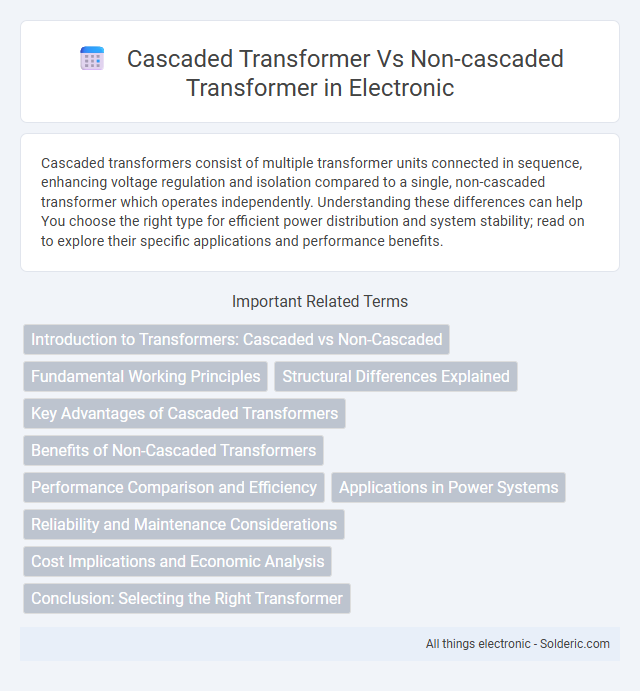Cascaded transformers consist of multiple transformer units connected in sequence, enhancing voltage regulation and isolation compared to a single, non-cascaded transformer which operates independently. Understanding these differences can help You choose the right type for efficient power distribution and system stability; read on to explore their specific applications and performance benefits.
Comparison Table
| Aspect | Cascaded Transformer | Non-Cascaded Transformer |
|---|---|---|
| Architecture | Multiple transformer blocks arranged sequentially, each refining previous outputs | Single transformer block or stacked layers without intermediate refinement |
| Performance | Improved accuracy due to progressive feature enhancement | Good performance but limited refinement capability |
| Latency | Higher latency due to sequential processing stages | Lower latency with faster inference |
| Complexity | More complex, requires careful tuning of stages | Simpler architecture, easier to implement |
| Use Cases | Tasks requiring iterative refinement such as image captioning, complex NLP tasks | General NLP tasks, real-time applications with latency constraints |
Introduction to Transformers: Cascaded vs Non-Cascaded
Transformers, integral to modern NLP, are categorized into cascaded and non-cascaded architectures based on their layer connectivity. Cascaded transformers feature sequential layering where outputs of one transformer directly feed into the next, enhancing context comprehension and performance in complex tasks. Non-cascaded transformers operate independently or in parallel layers, often prioritizing computation speed and simplicity at the expense of depth in contextual representation.
Fundamental Working Principles
Cascaded transformers consist of multiple transformer stages connected in series, allowing for stepwise voltage transformation and improved efficiency in high-voltage applications. Non-cascaded transformers operate as a single unit, performing voltage conversion in one step with simpler construction but potential limitations in handling extreme voltage levels. Your choice between cascaded and non-cascaded transformers depends on the specific voltage requirements and application complexity.
Structural Differences Explained
Cascaded transformers consist of multiple transformer stages connected sequentially, allowing each stage to progressively refine feature representations and enhance model depth without excessive parameter growth. Non-cascaded transformers rely on a single transformer layer or block, processing input in one stage, which limits hierarchical feature extraction and capacity for complex pattern recognition. The structural distinction lies in how cascaded architectures leverage stacked transformer modules to improve learning dynamics and representation power compared to singular, flat transformer designs.
Key Advantages of Cascaded Transformers
Cascaded transformers offer enhanced voltage regulation and improved efficiency by distributing electrical load across multiple transformer units, reducing voltage drops and losses compared to non-cascaded transformers. Their modular design facilitates easier maintenance and scalability for complex power systems, enabling greater operational flexibility and reliability. These transformers also improve fault tolerance, as failures in one stage do not necessarily compromise the entire system, enhancing overall resilience.
Benefits of Non-Cascaded Transformers
Non-cascaded transformers offer simpler design and easier maintenance due to their straightforward single-stage architecture, reducing complexity and potential points of failure. They typically require less space and lower initial investment, making them cost-effective for applications with moderate voltage requirements. Their efficiency in standard power distribution scenarios ensures reliable performance without the need for multiple transformation stages.
Performance Comparison and Efficiency
Cascaded transformers demonstrate enhanced performance by leveraging multi-stage processing, which refines feature extraction and improves accuracy compared to non-cascaded transformers. They exhibit higher computational efficiency due to progressive feature compression and selective attention at each stage, reducing redundant operations and memory usage. Non-cascaded transformers, while simpler, often require larger computational resources to achieve similar accuracy, leading to lower overall efficiency in complex tasks.
Applications in Power Systems
Cascaded transformers are widely used in power systems for applications requiring higher voltage levels and improved reliability, such as high-voltage transmission and distribution networks. Non-cascaded transformers, on the other hand, are typically employed in simpler, lower voltage applications like distribution transformers in residential or commercial areas. Your choice between cascaded and non-cascaded transformers should consider factors like voltage requirements, system complexity, and maintenance needs for optimal power system performance.
Reliability and Maintenance Considerations
Cascaded transformers enhance reliability by enabling modular fault isolation, reducing downtime during maintenance compared to non-cascaded transformers that typically require full system shutdowns. Maintenance of cascaded transformers is more flexible since individual units can be serviced or replaced without disrupting the entire power supply, improving system availability. Non-cascaded transformers often involve higher risks and longer outages during repair due to their integrated design, impacting overall operational continuity.
Cost Implications and Economic Analysis
Cascaded transformers, comprising multiple step-down and step-up units, often incur higher initial capital expenditure compared to non-cascaded transformers due to increased material and installation complexity. However, the improved voltage regulation and reduced losses in cascaded systems can lead to lower operational costs and extended equipment lifespan, enhancing long-term economic benefits. Non-cascaded transformers typically offer simplified maintenance and reduced upfront investment but may experience higher energy losses and less efficient performance, impacting total cost of ownership.
Conclusion: Selecting the Right Transformer
Cascaded transformers offer enhanced voltage regulation and increased efficiency by sequentially stepping voltage through multiple stages, making them ideal for applications requiring precise voltage control. Non-cascaded transformers, with simpler construction and lower initial cost, suit straightforward power distribution tasks where efficiency and fine voltage adjustments are less critical. Your choice depends on the specific voltage control needs, budget constraints, and system complexity of your electrical application.
cascaded transformer vs non-cascaded transformer Infographic

 solderic.com
solderic.com